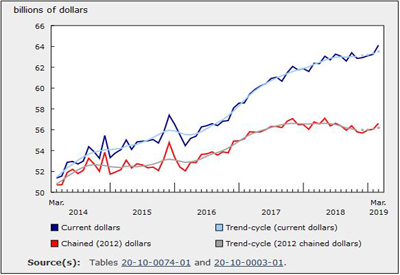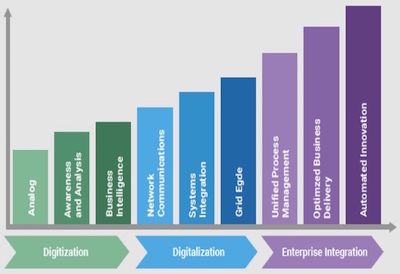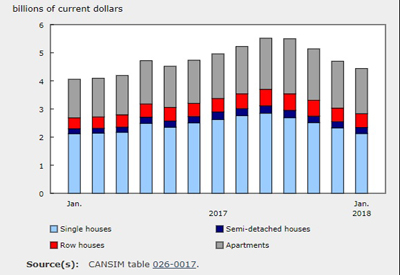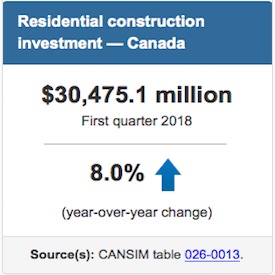February Wholesale Sales Up in 2 Subsectors, Down in 5
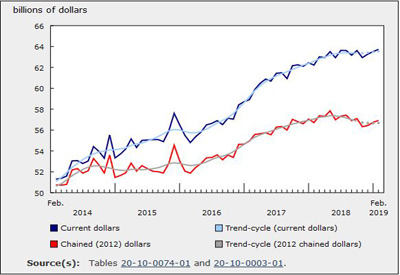
Apr 29, 2019
Wholesale sales increased 0.3% to $63.7 billion in February, the third consecutive monthly gain. Higher sales were recorded in two of seven subsectors, led by the motor vehicle and motor vehicle parts and accessories subsector. Excluding this subsector, wholesale sales declined 1.5%. In volume terms, wholesale sales increased 0.3%.
Sales increase in two of seven subsectors
In dollar terms, the motor vehicle and motor vehicle parts and accessories subsector reported the largest increase in February, as sales rose 9.5% to $11.6 billion. Sales were up in all three industries, led by the motor vehicle industry (+11.0%) following a 4.4% decline in January.
Sales in the miscellaneous subsector rose 0.5% to $8.5 billion in February, entirely on the strength of sales in the other miscellaneous industry (+7.8%).
Following two consecutive monthly gains, the building material and supplies subsector decreased 5.3% to $8.8 billion, the lowest level since January 2018. Declines were recorded in two of three industries, led by the lumber, millwork, hardware and other building supplies industry (-10.2%).
The machinery, equipment and supplies subsector declined for the third time in four months, down 1.3% to $13.1 billion in February. Three of the subsector’s four industries decreased in February, accounting for approximately 70% of the subsector’s sales. In dollar terms, the construction, forestry, mining and industrial machinery, equipment and supplies industry (-2.4%) contributed the most to the decrease.
Sales up in two provinces
In February, wholesale sales increased in Ontario and Saskatchewan. In dollar terms, Ontario accounted for most of the gain.
Wholesale sales increased for the third consecutive month in Ontario, up 2.1% to $33.1 billion. Sales were up in four of seven subsectors, led by the motor vehicle and motor vehicle parts and accessories subsector (+11.5% to $8.1 billion), its third increase in four months. Sales were also up in the machinery, equipment and supplies (+1.1% to $6.9 billion) and the food, beverage and tobacco (+0.8% to $4.9 billion) subsectors.
In Saskatchewan, sales increased for the third time in four months, up 7.5% to $2.4 billion. Higher sales in the miscellaneous subsector (+23.0% to $1.1 billion) offset declines reported in others.
In dollar terms, Alberta recorded the largest decline in February, with sales down 3.4% to $6.6 billion. This was the first decrease in three months and the lowest level since August 2017. Sales were down in six subsectors, led by the building material and supplies (-7.5% to $1.0 billion) and the machinery, equipment and supplies (-2.6% to $2.0 billion) subsectors.
The machinery, equipment and supplies subsector led declines in British Columbia, where sales decreased 3.4% to $6.3 billion. The subsector declined for the third consecutive month, down 8.1% to $1.0 billion in February. The miscellaneous (-8.5% to $713 million) and the food, beverage and tobacco (-3.8% to $1.4 billion) subsectors also contributed to lower sales in the province.
Sales in Quebec decreased for the third time in four months, down 0.5% to $11.9 billion. The food, beverage and tobacco (-2.2% to $3.0 billion) and the building material and supplies (-2.7% to $1.9 billion) subsectors contributed the most to the decrease in February. Despite the recent declines, wholesale sales in Quebec were up 4.3% year over year.
Inventories edge down
Following five consecutive monthly increases, wholesale inventories edged down 0.1% to $90.7 billion in February. Inventories were down in four of seven subsectors, representing about 58% of total wholesale inventories.
Inventories in the miscellaneous subsector decreased 2.5% in February, representing the largest decline in dollar terms. Four of five industries within this subsector decreased, with the agricultural supplies industry (-2.9%) representing the largest decline.
For the second consecutive month, inventories in the machinery, equipment and supplies subsector (-0.8%) declined. The other machinery, equipment and supplies industry fell 2.4%, the largest decrease of the subsector.
Inventories in the personal and household goods subsector (+2.0%) increased for the fourth consecutive month. Five of six industries within this subsector increased, led by the textile, clothing and footwear industry.
The inventory-to-sales ratio fell slightly from 1.43 in January to 1.42 in February. This ratio is a measure of the time in months required to exhaust inventories if sales were to remain at their current level.
Source: Statistics Canada, www150.statcan.gc.ca/n1/daily-quotidien/190423/dq190423b-eng.htm

